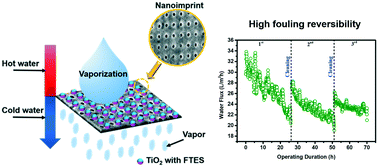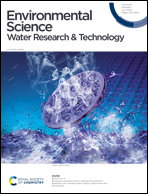Emerging investigator series: engineering membrane distillation with nanofabrication: design, performance and mechanisms†
Abstract
Anti-fouling and durability are two important parameters that are closely associated with the development and deployment of membrane distillation (MD). In this study, we reported a nanoimprinted, omniphobic polytetrafluoroethylene (PTFE) membrane with a hierarchical rough structure for the MD process. A highly ordered, circular surface pattern was first imparted to a PTFE membrane substrate via a nanoimprint technique. An ultrathin TiO2 layer was deposited onto the nanoimprinted membrane to create a spherical hierarchical rough structure via atomic layer deposition as well as an initiator for chemical fluorination of the membrane. The resultant, nanofabricated membrane exhibited a water contact angle of 155° and a contact angle above 100° against a range of low surface tension liquids. In addition, the nanofabricated membrane displayed a high and stable water flux of around 34 L m−2 h−1 for more than 24 hours, and nearly complete salt rejection with the presence of surfactants. Most importantly, the water flux recovery rate of the resultant membrane was more than 91.3% after three fouling–cleaning cycles, demonstrating excellent fouling reversibility. The new strategy proposed here that combines the nanoimprint technique and superhydrophobic modification sheds light on developing MD membranes with considerable durability and anti-fouling performance.

- This article is part of the themed collections: Emerging Investigator Series and Environmental Science: Water Research & Technology Cover Art


 Please wait while we load your content...
Please wait while we load your content...